
St Bartholomew's Church, dedicated to the apostle Bartholomew, is an Anglican church in Brighton, England. The neo-gothic building is located on Ann Street, on a sloping site between Brighton railway station and the A23 London Road, adjacent to the New England Quarter development. It is notable for its height – dominating the streets around it and being visible from many parts of the city – and its distinctive red-brick construction.

Grundtvig's Church is located in the Bispebjerg district of Copenhagen, Denmark. It is a rare example of expressionist church architecture. Due to its originality, it is one of the best known churches in the city.

Esbjerg is a seaport city and seat of Esbjerg Municipality on the west coast of the Jutland peninsula in southwest Denmark. By road, it is 71 kilometres (44 mi) west of Kolding and 164 kilometres (102 mi) southwest of Aarhus. With an urban population of 71,921 it is the fifth-largest city in Denmark, and the largest in West Jutland.

St Mary Star of the Sea is a Roman Catholic parish church in West Melbourne, Victoria, Australia. The foundation stone of the church was laid in 1882 and the building was completed by 1900. Since 2002, restoration has been ongoing to restore the church to its original state. Built with seating for over 1,200 people, it has been described as the largest parish church in Melbourne, in Victoria, or even in Australia.

Christ Church is a Church of Denmark parish church situated on Enghave Plads in the Vesterbro district of Copenhagen, Denmark. It was designed by Valdemar Koch, who also built several other churches in Copenhagen around that time. Completed in 1900, it was the first new church to be opened in the fast-growing neighbourhood to relieve the pressure on St. Mathew's. Its style is inspired by Italian Romanesque church architecture.

St James with Holy Trinity Church is in Seamer Road, Scarborough, North Yorkshire, England. It is an active Anglican parish church in the deanery of Scarborough, the archdeaconry of East Riding, and the diocese of York. The church is recorded in the National Heritage List for England as a designated Grade II listed building.

Allinge Church is the parish church of Allinge-Sandvig on the Danish island of Bornholm. It stands at the centre of Allinge on a hill some 11 metres above sealevel. Initially just a small granite longhouse from the around the 14th century, in 1892 it was completely rebuilt in the Neogothic style.

Nexø Church is the parish church of Nexø, a port on the eastern coast of the Danish island of Bornholm.

The Trinitatis Church is located in central Copenhagen, Denmark. It is part of the 17th century Trinitatis Complex, which includes the Rundetårn astronomical observatory tower and the Copenhagen University Library, in addition to the church. Built in the time of Christian IV, the church initially served the students of Copenhagen University. It is situated at the corner of Landemærket and Købmagergade. The interior was seriously damaged in the fire of 1728 but was rebuilt in 1731.
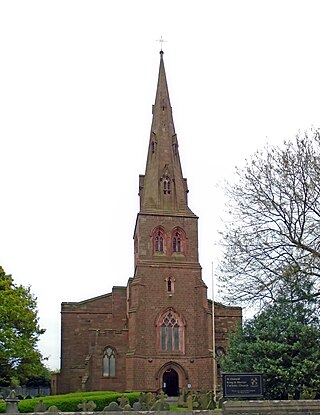
St Oswald's Church is a Roman Catholic parish church in St Oswald's Street, Old Swan, Liverpool, Merseyside, England. It is an active parish church in the Archdiocese of Liverpool and in St Joseph's Pastoral Area. The church is recorded in the National Heritage List for England as a designated Grade II listed building.
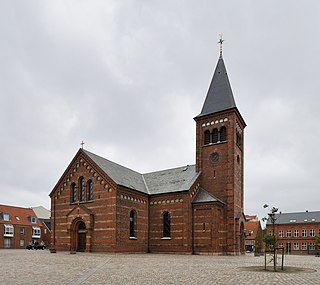
The Church of Our Saviour is a parish church in Esbjerg, Denmark. Completed in 1887 to a design by Axel Møller, it was the first church to be built in the rapidly growing new town.

St Nikolaj Church is a Roman Catholic parish church in Esbjerg in the southwest of Jutland, Denmark. Designed by Johan Otto von Spreckelsen, the rectangular building of aerated concrete was completed and consecrated in 1969.
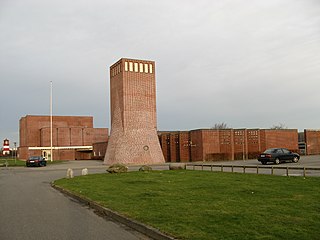
Sædden Church is a church of the Church of Denmark in Esbjerg in the southwest of Jutland, Denmark. Designed by Inger and Johannes Exner, the almost cube-shaped building with a tall, free-standing bell tower was completed and consecrated in 1978.
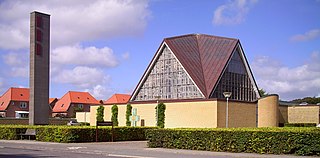
Trinity Church is a modern church in Esbjerg in the southwest of Jutland, Denmark. Designed by local architects Erik Flagstad Rasmussen and Knud Thomsen, the yellow-brick building with large triangular stained-glass windows was completed in 1961.

Gjesing Church, also Gesing Church, is a modern church in Esbjerg in the southwest of Jutland, Denmark. Designed by architects Niels Munk and Keld Wohlert, the red-brick building with a steeply pitched roof was completed in 1983.

Holy Trinity Church is a heritage-listed Anglican church at 141 Brookes Street, Fortitude Valley, City of Brisbane, Queensland, Australia. It is the second church on that site. It was designed by Francis Drummond Greville Stanley built from 1876 to 1877 by James Robinson. It was modified in 1920–1921, 1925 and 1929. It was added to the Queensland Heritage Register on 21 October 1992.
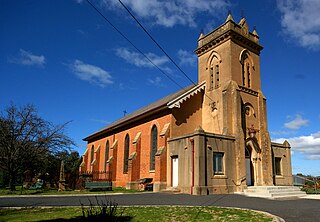
Holy Trinity Anglican Church is a heritage-listed Anglican church precinct, containing the church, rectory and adjacent cemetery, at 71-85 Gilmour Street, Kelso, Bathurst Region, New South Wales, Australia. The church was built from 1833 to 1878, with John Foster being responsible for the building of the original church. Edmund Blacket designed the rectory. The property is owned by Anglican Property Trust Diocese of Bathurst and Parish of Kelso, Anglican Diocese of Bathurst. It was added to the New South Wales State Heritage Register on 14 January 2011.

Lundtofte Church is a Church of Denmark parish church in Lyngby-Taarbæk Municipality in the northern suburbs of Copenhagen, Denmark. It was completed in 1921 but is built in the style of a typical Danish white-washed village church.

The Citadel Church is located in the Kastellet in Copenhagen, the capital of Denmark. The church was originally reserved for the garrison of the castle, but in 1902 also incorporated a civil parish. The Citadel Church celebrated its 300th anniversary in 2004.

Saint Peter's Church is a Lutheran church located in the center of Slagelse, Denmark. The congregation was originally part of the Roman Catholic Church, but was converted to Lutheranism during the Reformation.





















